
Below is the 10-minute bar chart for the SPY. The market was clicking this morning, keeping the rising trend going from the close yesterday. However, it turned south on the announcement that tariffs on Canada, Mexico and China were set to happen tomorrow (Saturday). Tariffs in general are thought to be bad for the market, particularly for global companies as the cost of doing business rises. This could also prove a problem for inflation. The Fed is watching carefully from the sidelines.
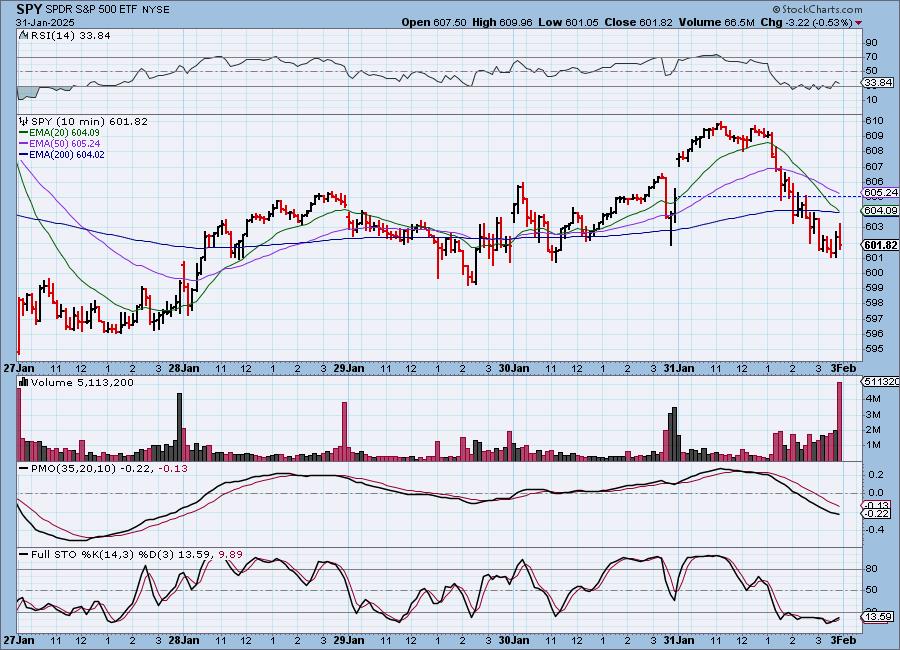
The DecisionPoint Alert Weekly Wrap presents an end-of-week assessment of the trend and condition of the Stock Market, the U.S. Dollar, Gold, Crude Oil, and Bonds. The DecisionPoint Alert daily report (Monday through Thursday) is abbreviated and gives updates on the Weekly Wrap assessments.
Watch the latest episode of DecisionPoint on our YouTube channel here!
MARKET/SPX SECTOR/INDUSTRY GROUP INDEXES
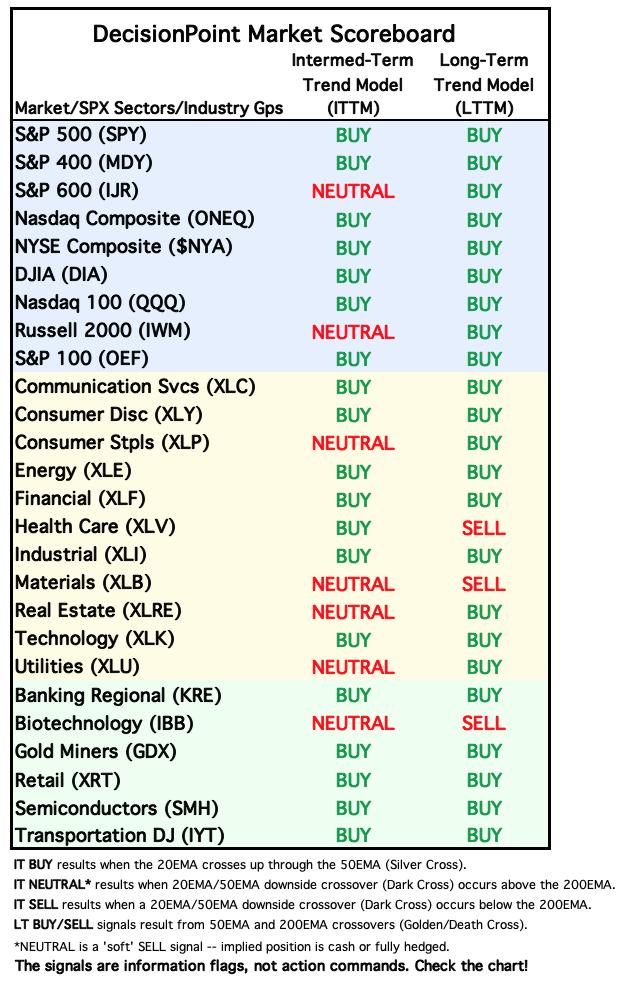
Change Today: 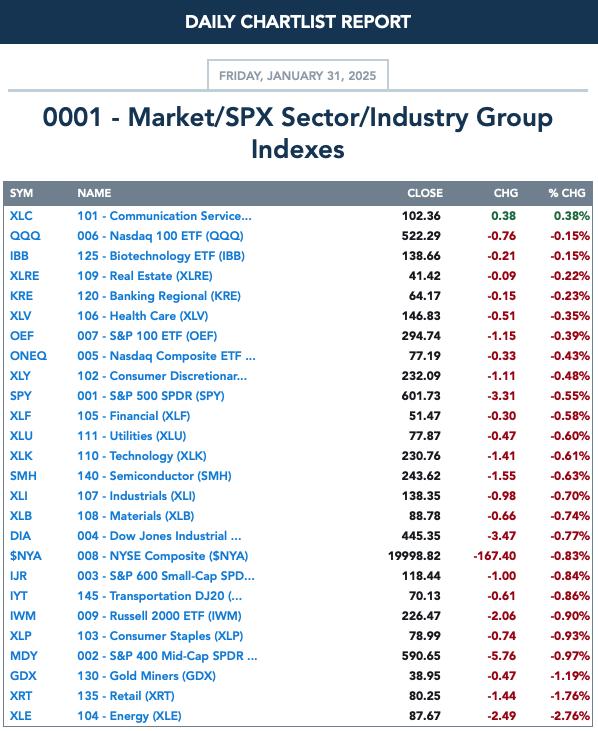
Change for the Week:
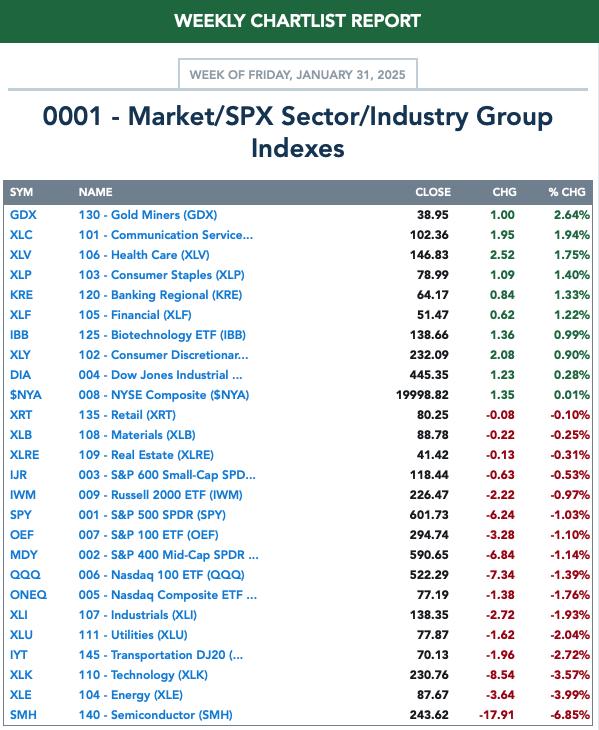
CLICK HERE for Carl's annotated Market Index, Sector, and Industry Group charts.
THE MARKET (S&P 500)
IT Trend Model: BUY as of 8/14/2024
LT Trend Model: BUY as of 3/29/2023
SPY Daily Chart: Instead of finishing higher as appeared we would this morning, the market took a turn and erased those gains and then some. This caused the formation of a bearish engulfing candlestick that would imply a decline on Monday.
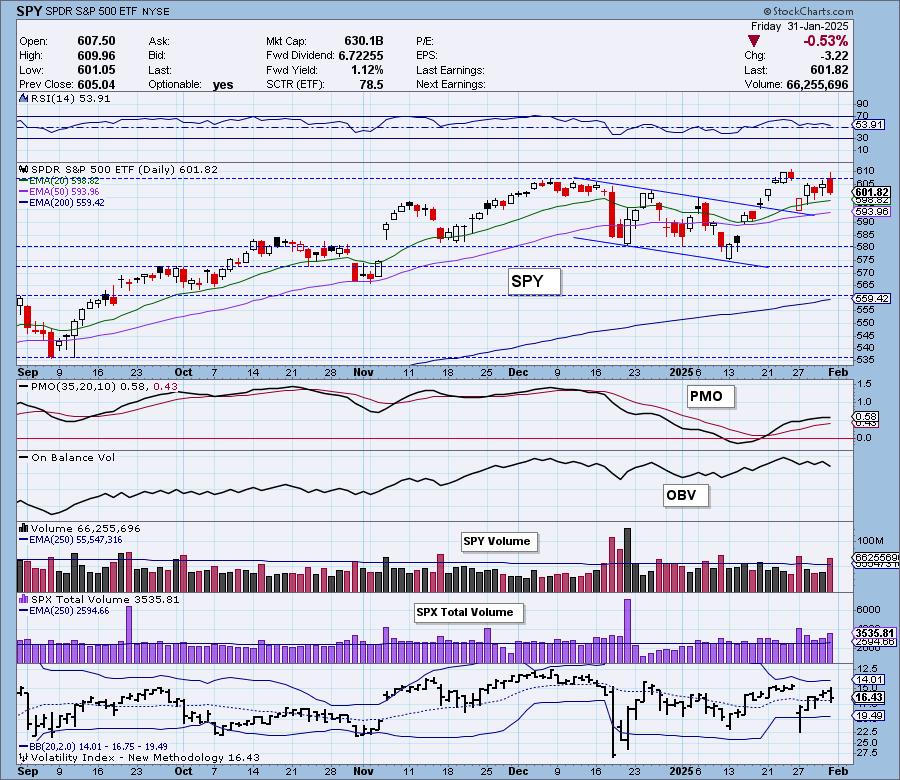
The VIX did see higher readings today as investors mulled over the tariffs. It is still within its Bollinger Bands, but is below its moving average on the inverted scale which suggests weakness. It's hard to see, but Stochastics turned down and are below 80 so internal weakness could be seeping in.
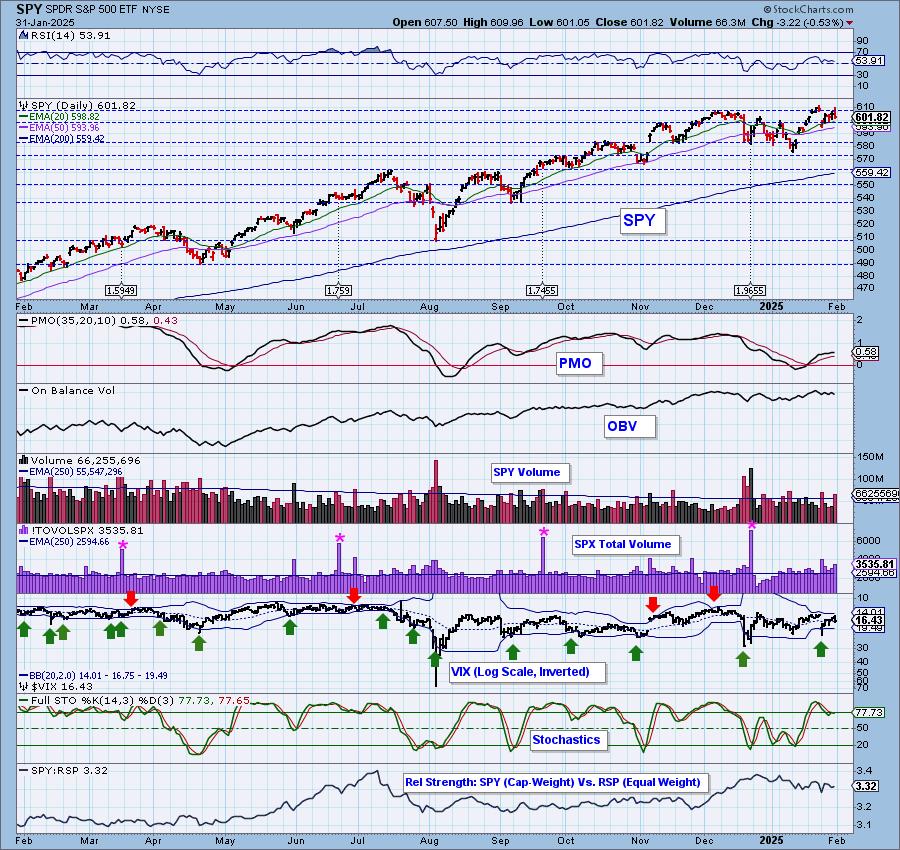
Here is the latest recording from 1/27. Click HERE to get the link to the video library.
SPY Weekly Chart: The bearish rising wedge still dominates the chart and does imply that we will eventually see a breakdown of the rising bottoms trendline. The weekly PMO is showing a negative divergence with price tops and it is currently in decline below its signal line. It's vulnerable.
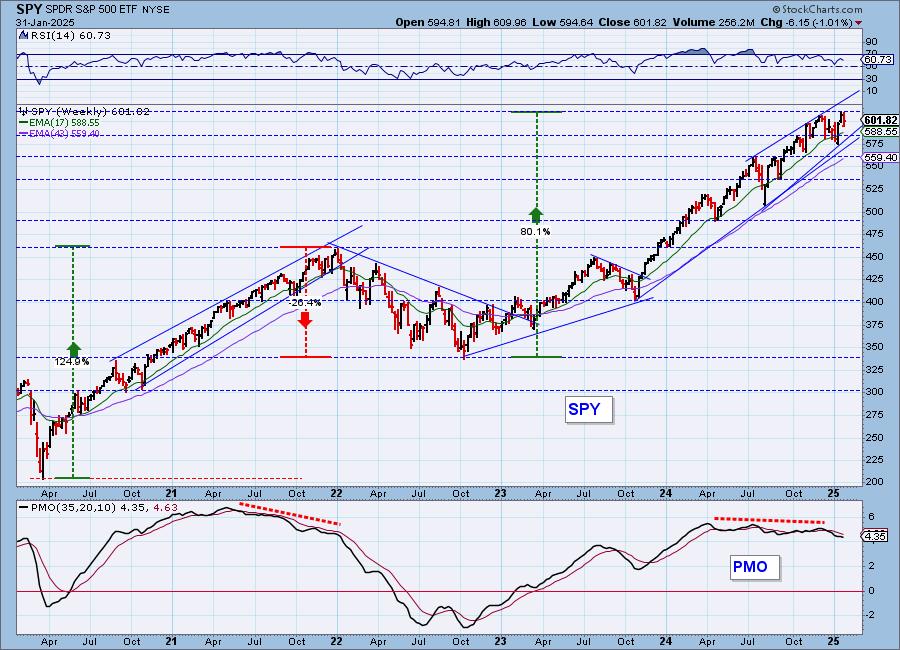
SPY Monthly Chart: The monthly chart shows a dangerous parabolic advance. You can see what happened after the last parabolic move so we should be on alert for a possible correction. The monthly PMO does still look bullish however, so this parabola could continue to build a bit longer.
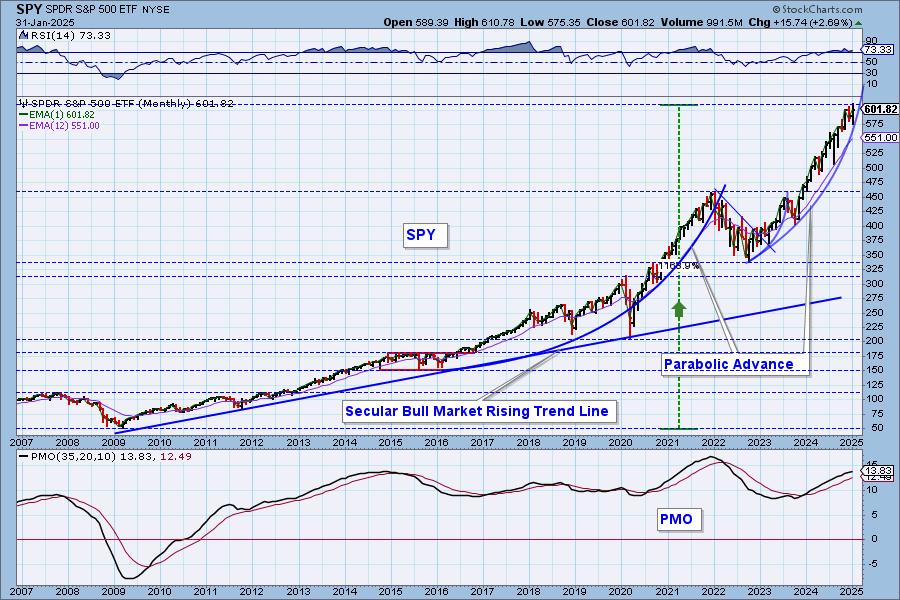
New 52-Week Highs/Lows: New Highs pared back as we would expect on a decline. New Lows did contract. The High-Low Differential is still rising which is positive in the intermediate term.
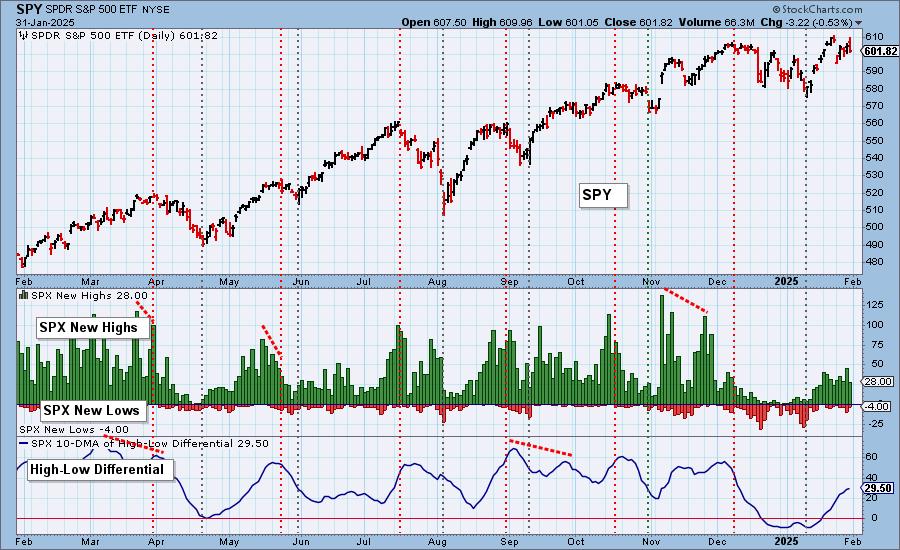
Climax Analysis: Today there were three climax readings (and one "almost") on the four relevant indicators, so we have a downside initiation climax. We should expect downside followthrough next week.
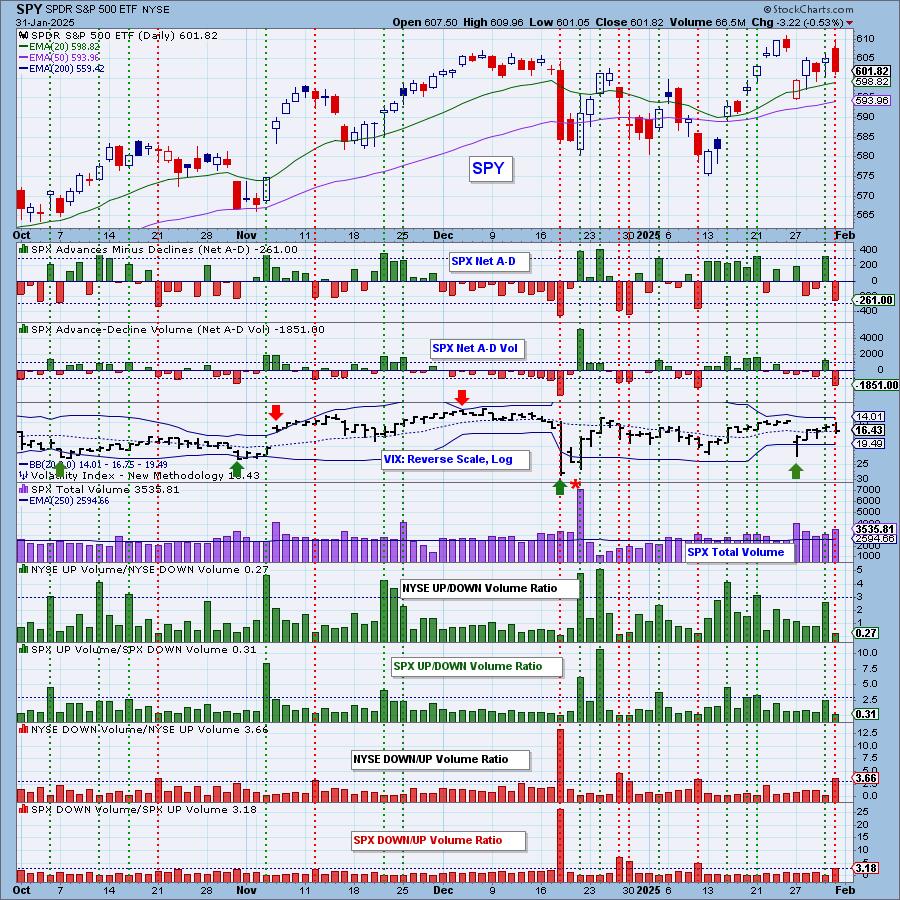
*A climax is a one-day event when market action generates very high readings in, primarily, breadth and volume indicators. We also include the VIX, watching for it to penetrate outside the Bollinger Band envelope. The vertical dotted lines mark climax days -- red for downside climaxes, and green for upside. Climaxes are at their core exhaustion events; however, at price pivots they may be initiating a change of trend.
Short-Term Market Indicators: The short-term market trend is UP and the condition is NEUTRAL.
The Swenlin Trading Oscillators (STOs) are both declining. The STO-B had turned up yesterday, but today it reversed back down. The STO-V has now reached negative territory. These indicators can accommodate much more downside before they even think about getting oversold. Participation of stocks above their 20-day EMAs contracted. %PMOs Rising also contracted. Both indicators are in declining trends.
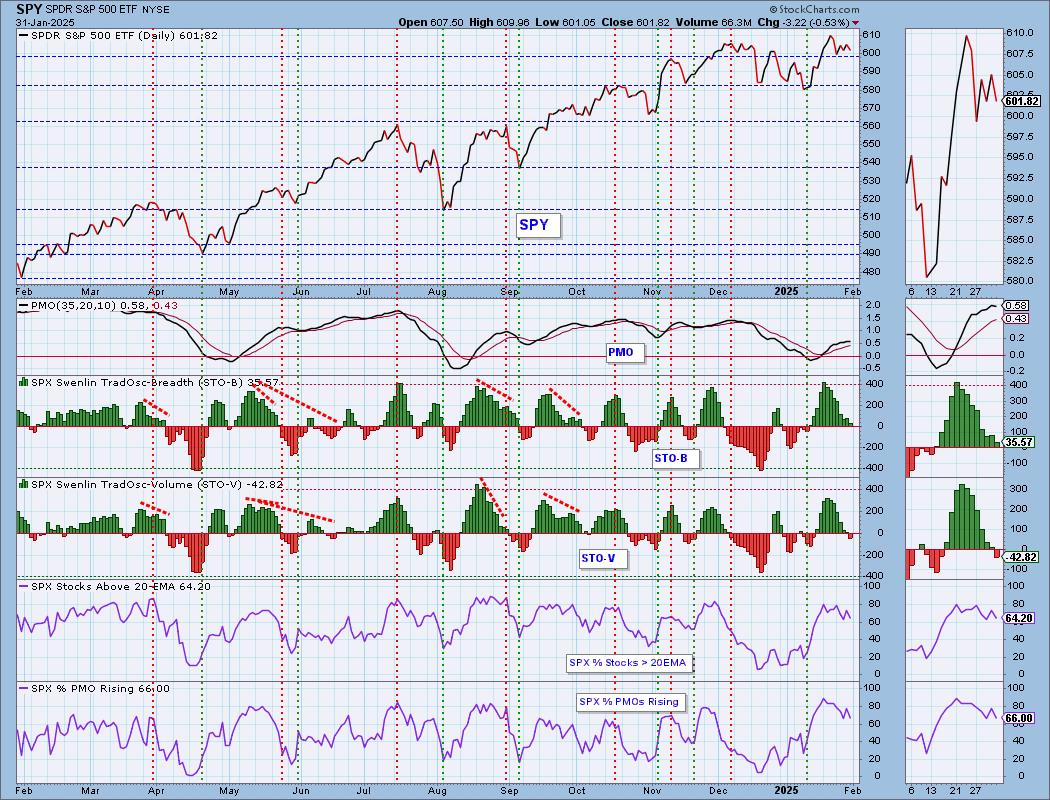
Intermediate-Term Market Indicators: The intermediate-term market trend is UP and the condition is SOMEWHAT OVERBOUGHT.
The ITBM and ITVM both topped in what we would call "somewhat overbought" territory. This is dangerous. We haven't seen them decline in some time. We can see what happened the last time they topped. %PMO Xover BUY Signals continued to decline toward the signal line. We don't like the deterioration on this chart.
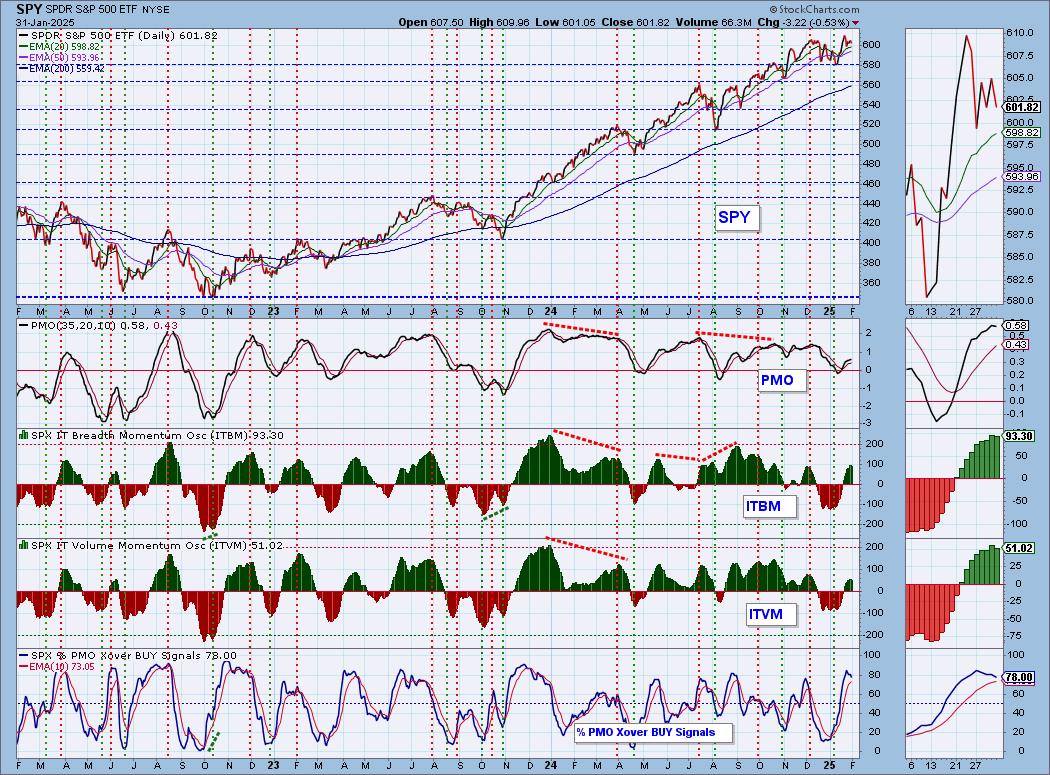
_______
PARTICIPATION TABLES: The following tables summarize participation for the major market indexes and sectors. The 1-Week Change columns inject a dynamic aspect to the presentation. There are three groups: Major Market Indexes, Miscellaneous Industry Groups, and the 11 S&P 500 Sectors.
Interestingly the Semiconductor (SMH) group has the highest IT Bias. The chart is still very unimpressive so we wouldn't get too excited by the reading. Notice how many percentage points were lost on the Silver Cross Index!
The lowest IT Bias goes to Real Estate (XLRE). It is trying to make a comeback, but it lost percentage points on both the Silver Cross Index and the Golden Cross Index.
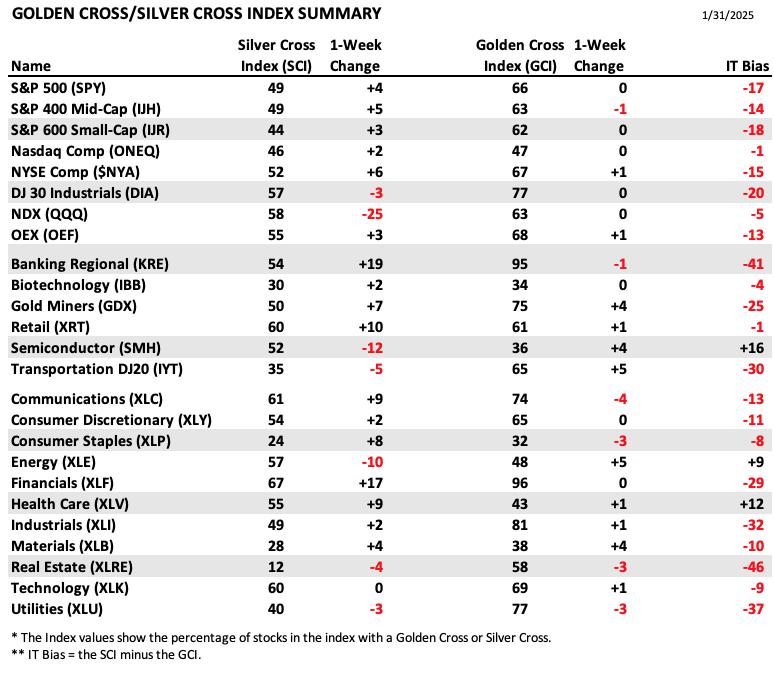
This table is sorted by SCI values. This gives a clear picture of strongest to weakest index/sector in terms of intermediate-term participation.
Financials (XLF) are definitely making a move. It now holds the highest SCI value and gained a huge 17 percentage points on the Silver Cross Index. It holds the highest GCI reading as well.
The Nasdaq 100 (QQQ) lost 25 percentage points on the SCI this week! Technology is very vulnerable.
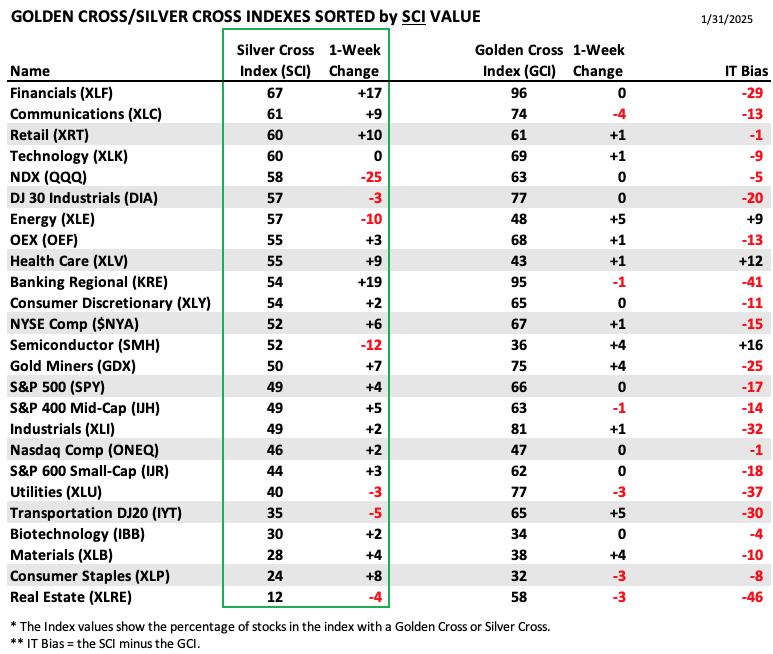
This table is sorted by GCI values. This gives a clear picture of strongest to weakest index/sector in terms of long-term participation.
Energy (XLE) may've gained the most Golden Cross Index points, but it is a sector in serious decline. It lost 10 percentage points on the SCI.
Transports (IYT) also gained five percentage points on the GCI. However, it lost ground on the SCI so it isn't configured very positively overall.
The strong Communication Services (XLC) sector lost the most GCI points, but had an excellent gain on the SCI so we don't see it as very damaging.
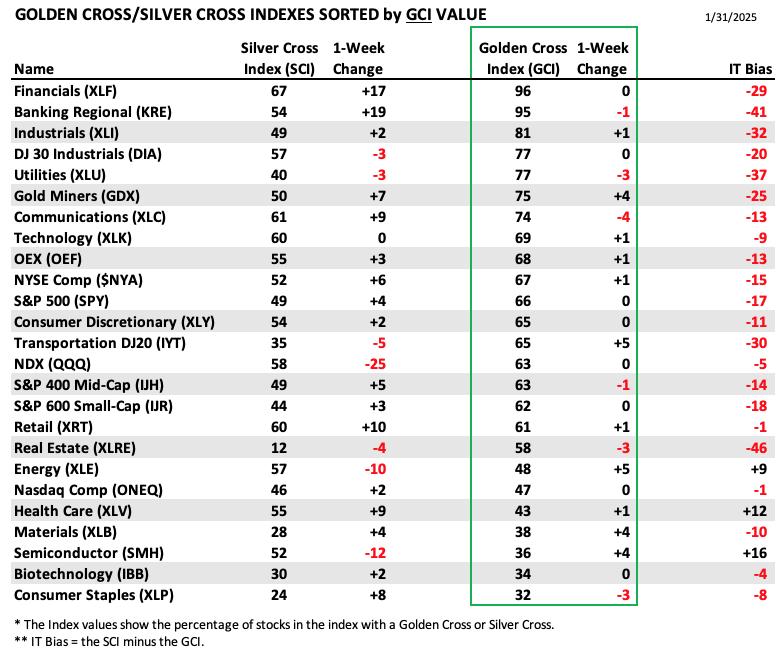
PARTICIPATION CHART (S&P 500): The following chart objectively shows the depth and trend of participation for the SPX in two time frames.
- Intermediate-Term - the Silver Cross Index (SCI) shows the percentage of SPX stocks on IT Trend Model BUY signals (20-EMA > 50-EMA). The opposite of the Silver Cross is a "Dark Cross" -- those stocks are, at the very least, in a correction.
- Long-Term - the Golden Cross Index (GCI) shows the percentage of SPX stocks on LT Trend Model BUY signals (50-EMA > 200-EMA). The opposite of a Golden Cross is the "Death Cross" -- those stocks are in a bear market.
The market bias is BULLISH in the intermediate term.
The market bias is BEARISH in the long term.
Participation is shrinking, but we do note that the Silver Cross Index has bottomed above the signal line. The SCI could continue to rise from here given we have so many more stocks above their 50-day EMA versus Silver Crosses within the index. It is above its signal line so the IT Bias is BULLISH. The reading itself isn't that healthy. The Golden Cross Index is rising again, but that will likely change as there are fewer stocks above their 200-day EMA than there are Golden Crosses. It is in weak territory (although we've seen it much lower). It is below its signal line so the LT Bias is BEARISH. The bias is deteriorating as participation begins to see declining trends.
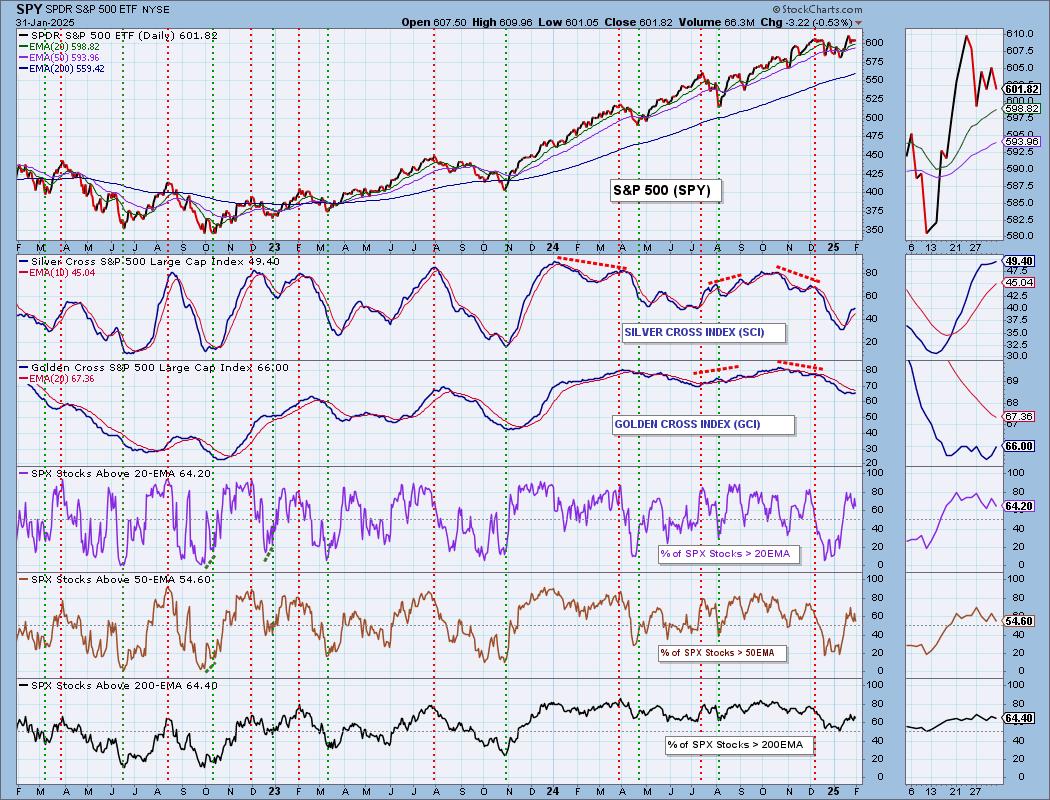
BIAS Assessment: The following table expresses the current BIAS of various price indexes based upon the relationship of the Silver Cross Index to its 10-day EMA (intermediate-term), and of the Golden Cross Index to its 20-day EMA (long-term). When the Index is above the EMA it is bullish, and it is bearish when the Index is below the EMA. The BIAS does not imply that any particular action should be taken. It is information to be used in the decision process.
The items with highlighted borders indicate that the BIAS changed today.
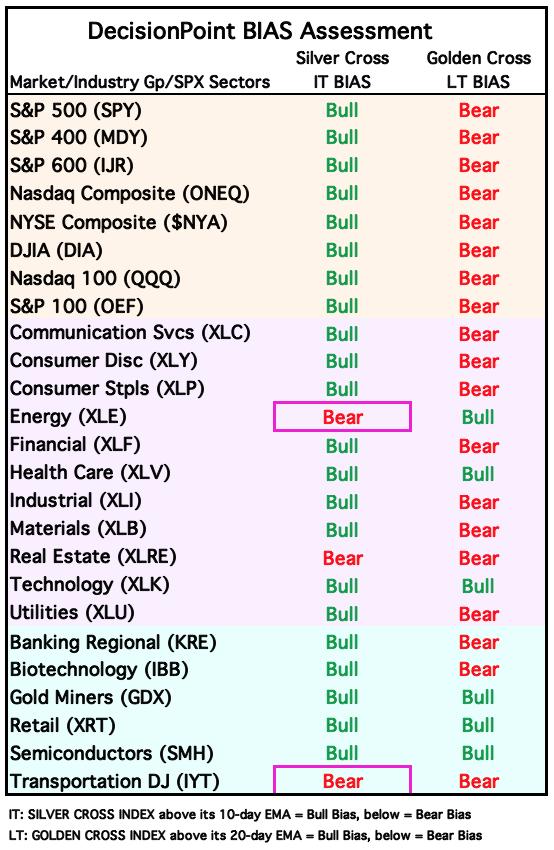
*****************************************************************************************************
CONCLUSION: The market rally is tenuous on today's decline. We have a bearish catalyst in tariffs and unlike the one day DeepSeek decline on Monday, we think this one could stick. We have price near all-time highs which is strong resistance. There is a new downside initiation climax and a bearish engulfing candlestick, both of which tell us to expect lower prices. The STOs are in decline and the ITBM and ITVM topped today. We think we're likely in for a new leg down, particularly if earnings don't impress as we move forward. Even good earnings may not be enough to keep it elevated given the specter of new tariffs. Prepare for downside next week.
Erin is 50% long, 0% short. (This is intended as information, not a recommendation.)
*****************************************************************************************************
CALENDAR
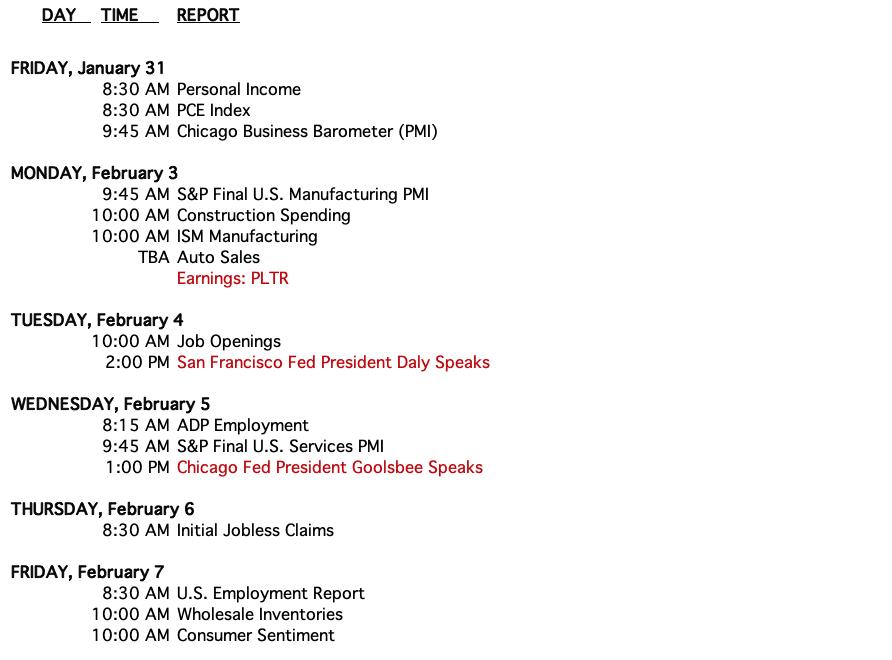
Have you subscribed the DecisionPoint Diamonds yet? DP does the work for you by providing handpicked stocks/ETFs from exclusive DP scans! Add it with a discount! Contact support@decisionpoint.com for more information!
BITCOIN
Bitcoin Daily Chart: Bitcoin has established a tighter trading range. The PMO just had a negative Crossover SELL Signal so it is vulnerable to making its way back down to longer-term support at 90,000. We haven't seen much out of Bitcoin since the election rally. We think that fundamentally there is still bullish sentiment associated with Bitcoin and that suggests to us that we will eventually get a rally out of the trading range. We just may have to endure another test of support before that happens.
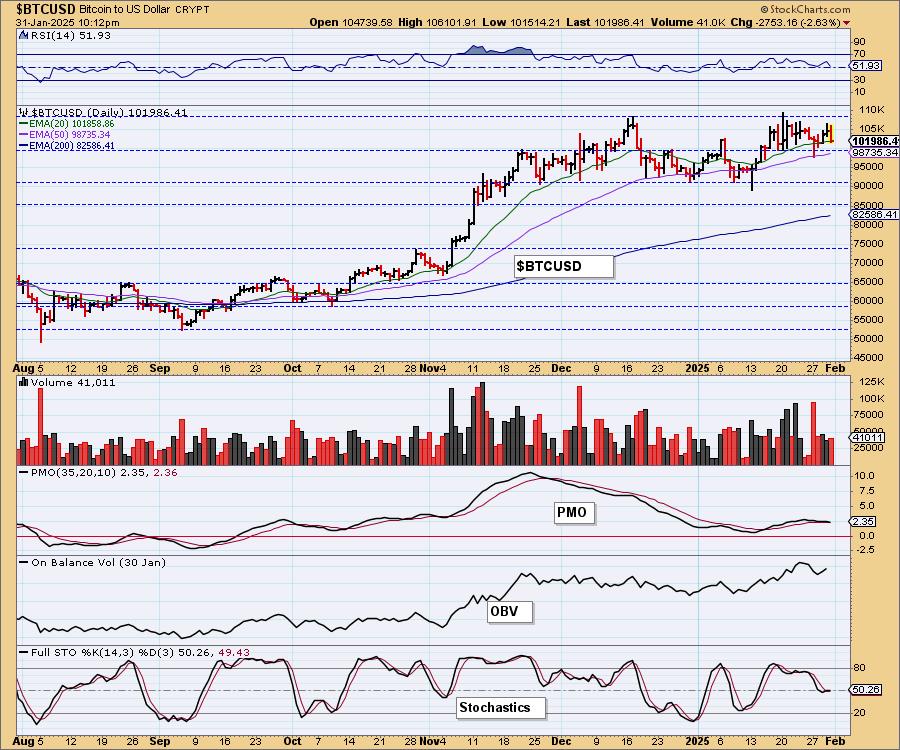
Bitcoin Weekly Chart: We have to say that it is looking concerning now on the weekly chart. We could be setting up a bearish double top so we should be careful about expanding positions in crypto. While we do expect a breakout versus a breakdown, this chart tells us to be cautious.
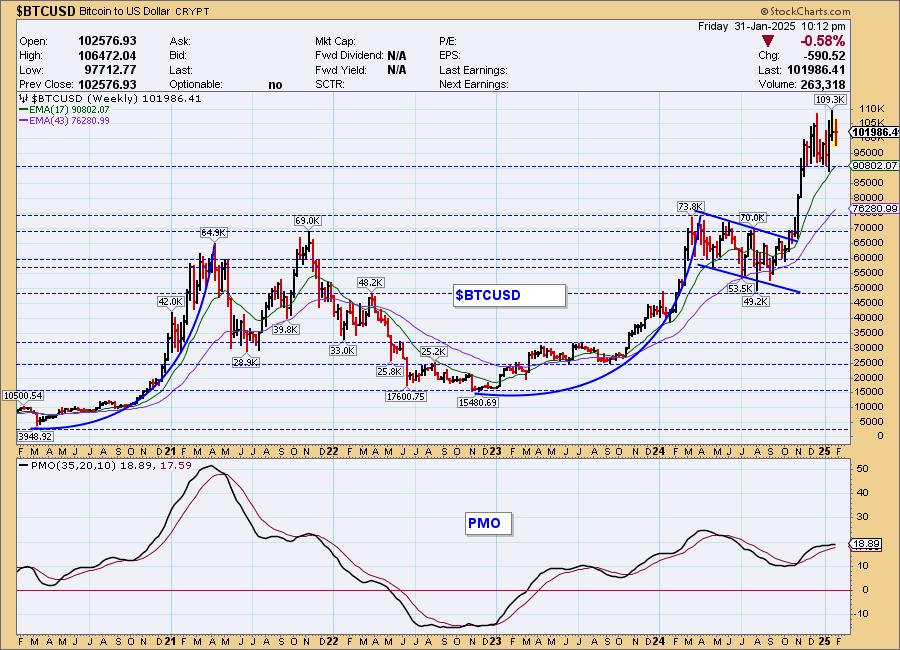
BITCOIN ETFs
Today:
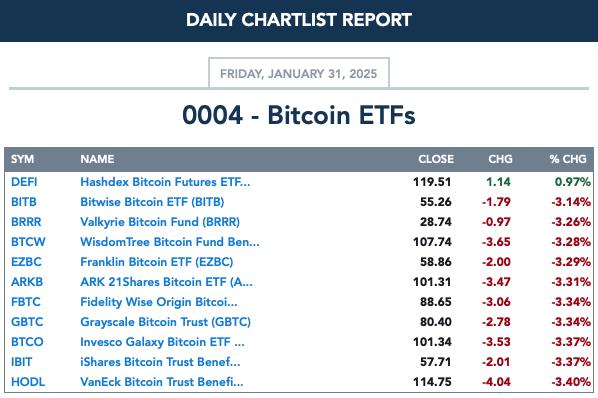
This Week:
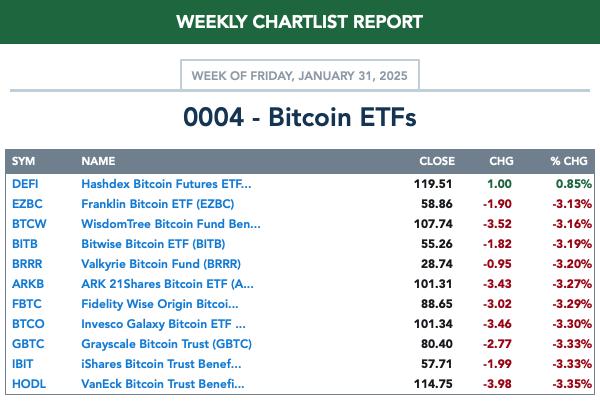
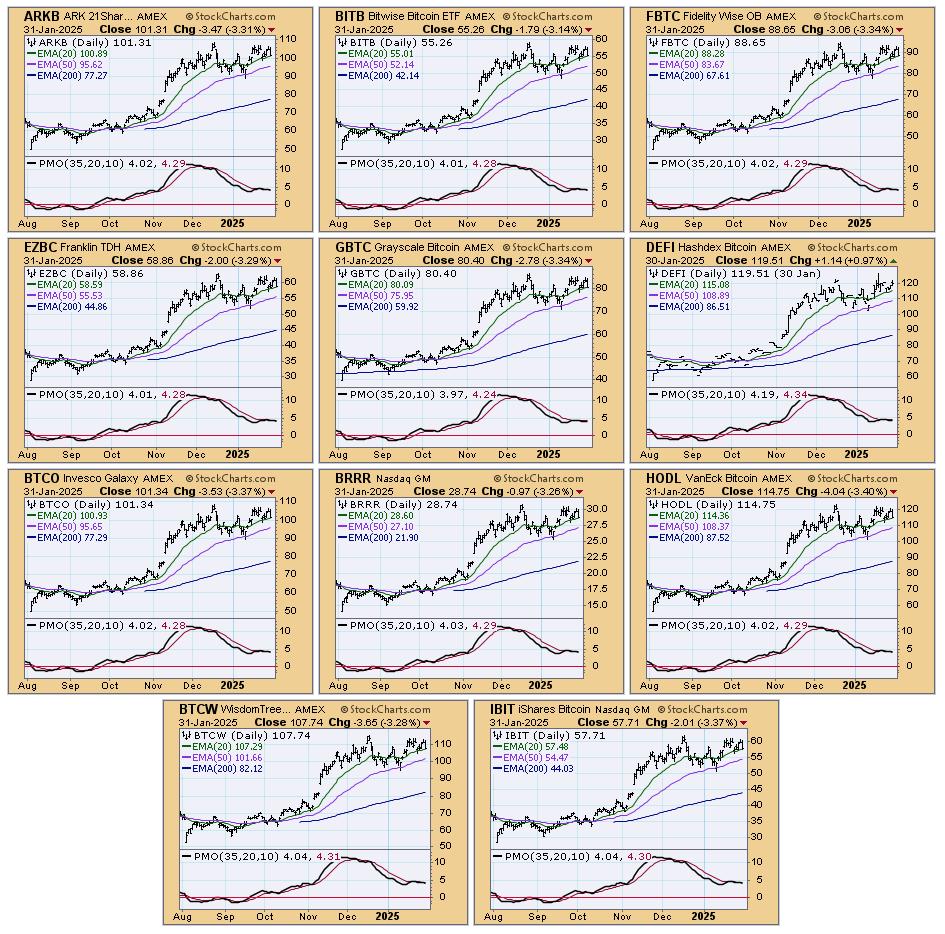
INTEREST RATES
Yields are in pullback mode as they've all established declining trends. The longer-term rising trends are still intact for long-term yields, but we are expecting a breakdown.
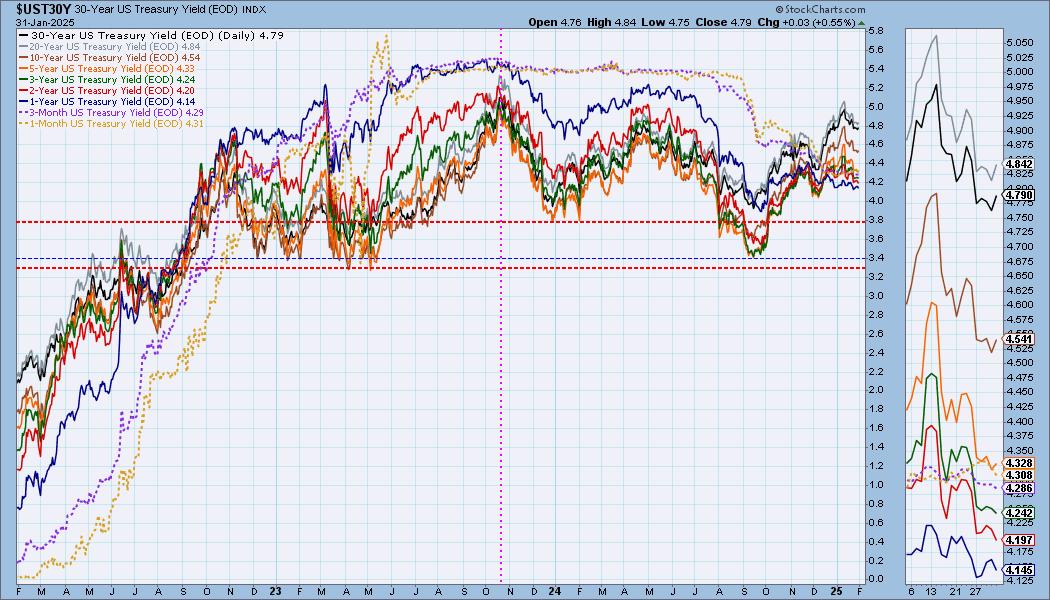
The Yield Curve Chart from StockCharts.com shows us the inversions taking place. The red line should move higher from left to right. Inversions are occurring where it moves downward.
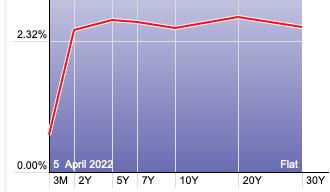
10-YEAR T-BOND YIELD
$TNX is so far preserving its rising trend, but given the bearish head and shoulders pattern, we think this is temporary. The PMO is in decline and Stochastics are below 20 so there is plenty of weakness on the chart to add to the bearish chart pattern.
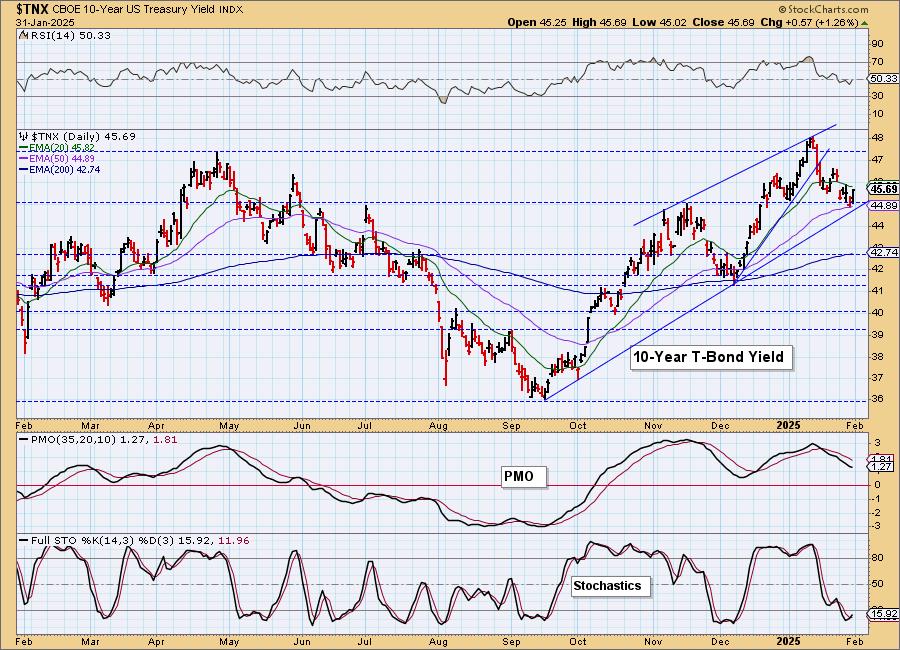
10-Year Bond Yield Weekly Chart: It hit overhead resistance and is pulling back from here. It does look as if we'll see more decline toward 3.5%. We aren't convinced it will get that low but the weekly PMO has topped so we'll see.
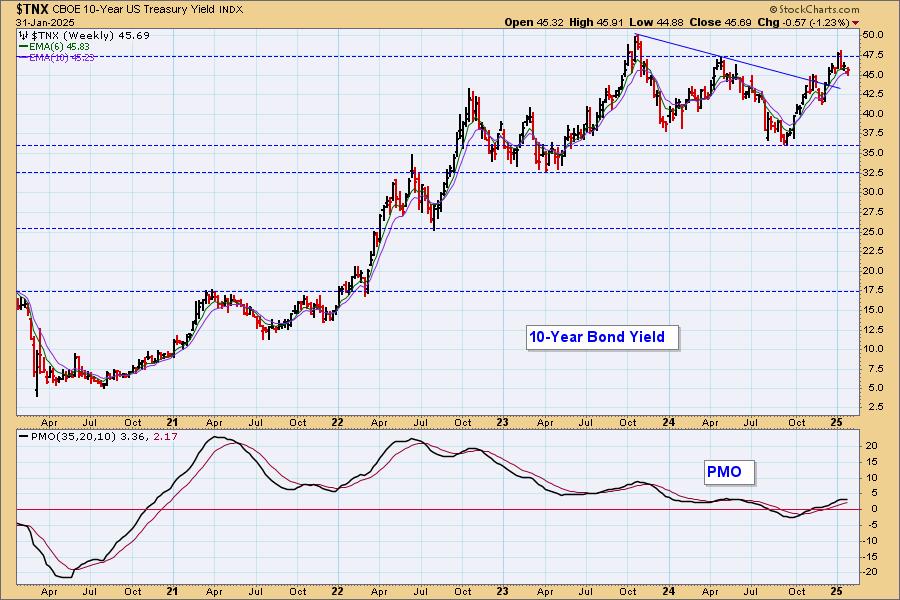
MORTGAGE INTEREST RATES (30-Yr)**
**We watch the 30-Year Fixed Mortgage Interest Rate, because, for the most part, people buy homes based upon the maximum monthly payment they can afford. As rates rise, a fixed monthly payment will carry a smaller mortgage amount, which shuts many buyers out of the market, and potential sellers will experience pressure to lower prices (to no effect so far).
--
This week the 30-Year Fixed Rate changed from 6.96 to 6.95.
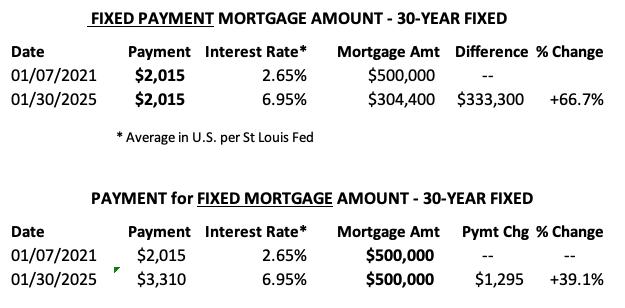
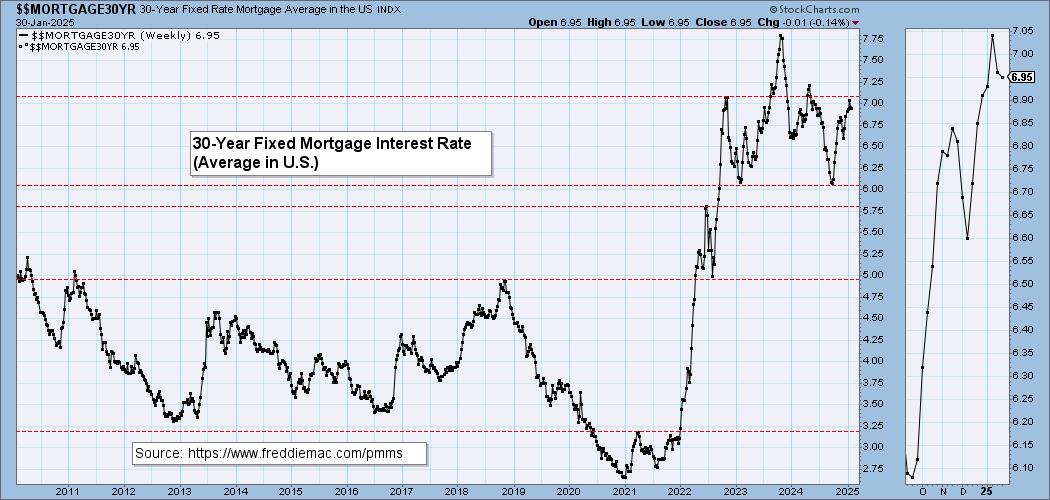
Here is a 50-year chart for better perspective.
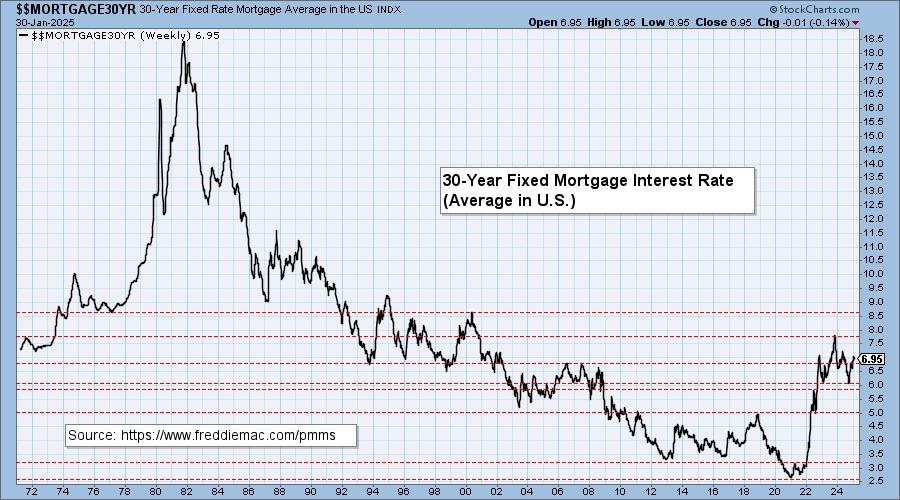
BONDS (TLT)
IT Trend Model: NEUTRAL as of 11/10/2024
LT Trend Model: SELL as of 12/13/2024
TLT Daily Chart: TLT had a bad day and that has turned the PMO down well below the zero line. We think this temporary and that the bullish reverse head and shoulders will win out as yields pull back. Stochastics did top as well, but you can see the declining trend on the 20-year yield. We don't think it is ripe for reversal yet.
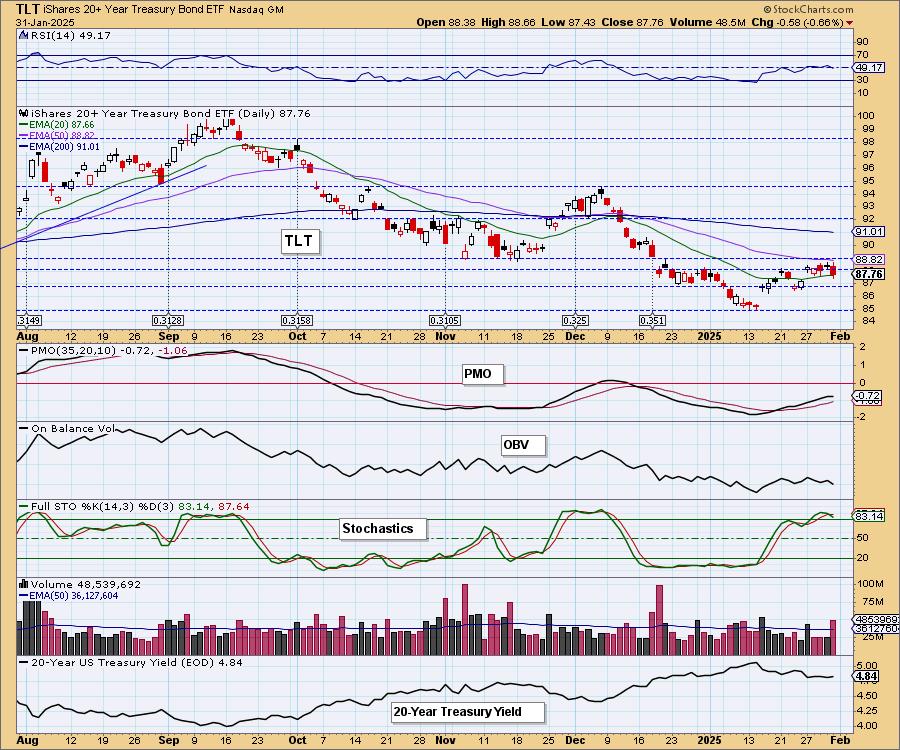
The minimum upside target of the reverse head and shoulders pattern would take price to 91 or 92. This seems reasonable.
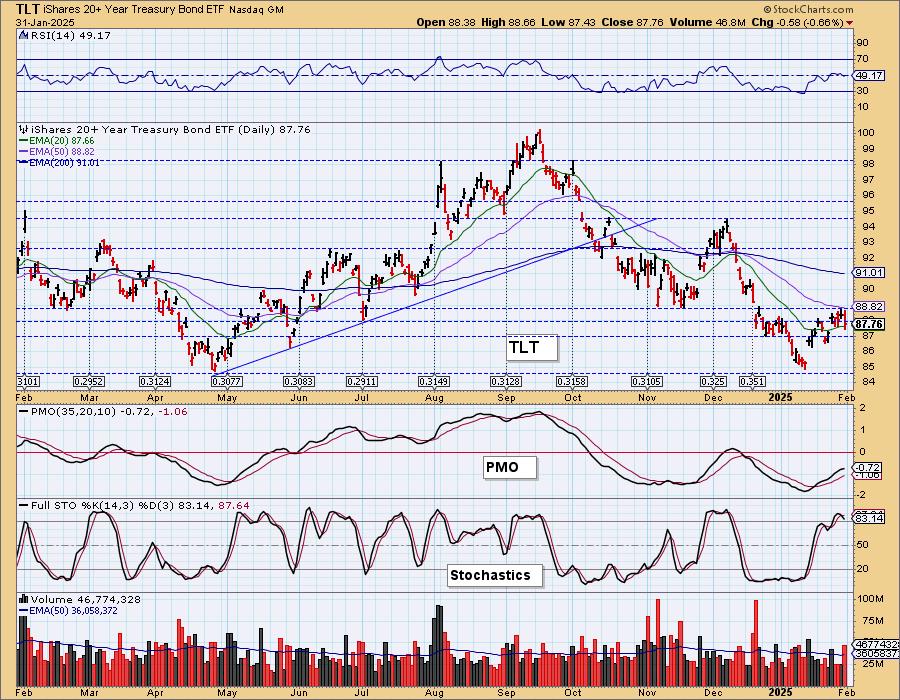
TLT Weekly Chart: This is actually a strong level of support that price is reversing off. It is about to break the declining tops trendline. The weekly PMO is trying to turn up which is part of the reason why we think TLT is headed higher from here. Time to break the near-term declining trend.
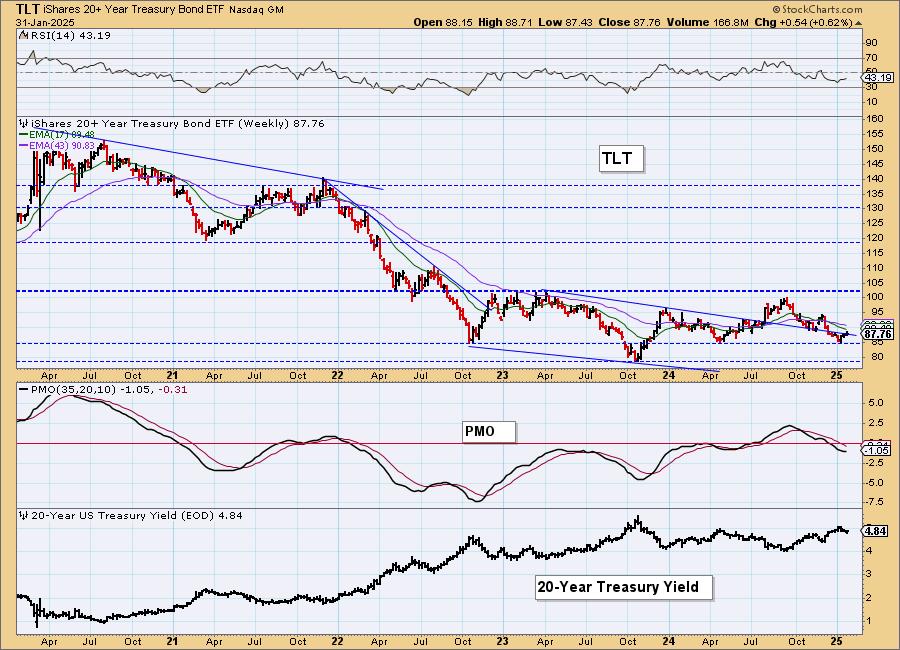
TLT Monthly Chart: The monthly chart does show a bottoming formation, but the monthly PMO doesn't look very healthy. As we noted above we see a high likelihood that price will get to 91 or 92, but we aren't looking for much more than that.
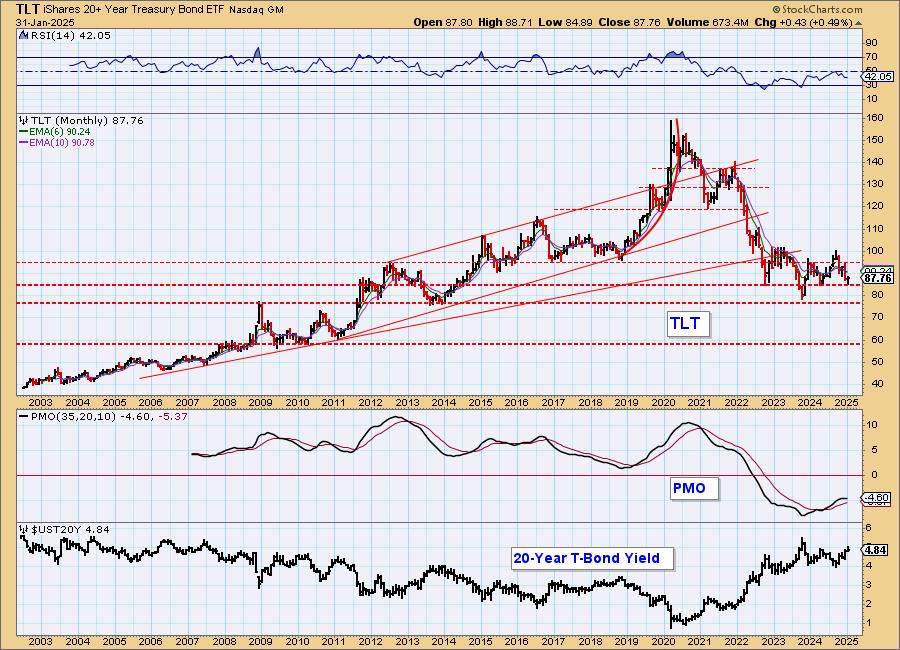
DOLLAR (UUP)
IT Trend Model: BUY as of 10/9/2024
LT Trend Model: BUY as of 5/25/2023
UUP Daily Chart: The Dollar is rallying out of a bull flag formation. The PMO is turning up and Stochastics are rising. The RSI is back in positive territory so we should expect more upside out of the Dollar.
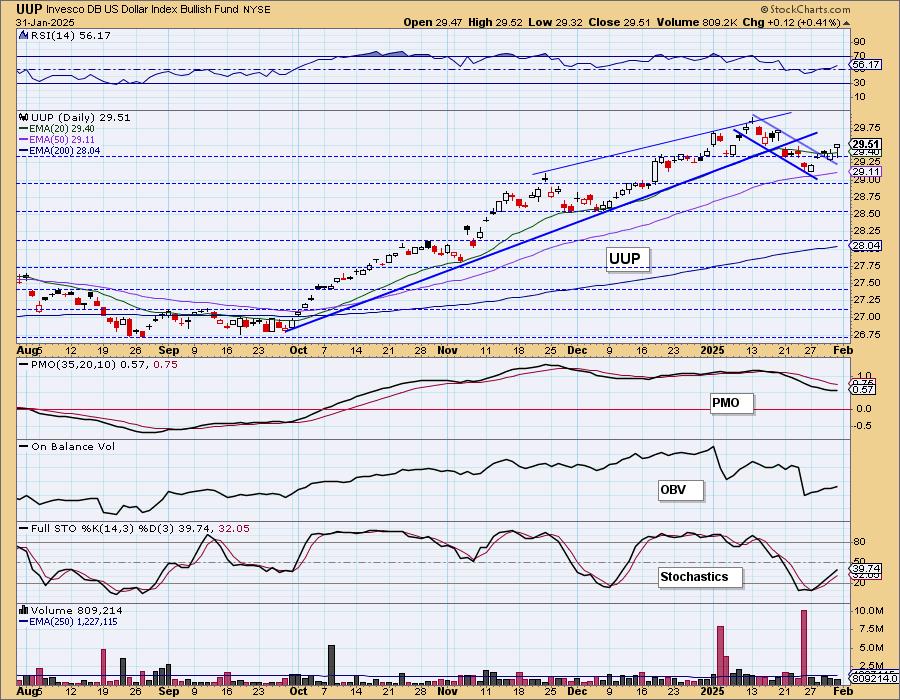
We would look for a test of this year's high.
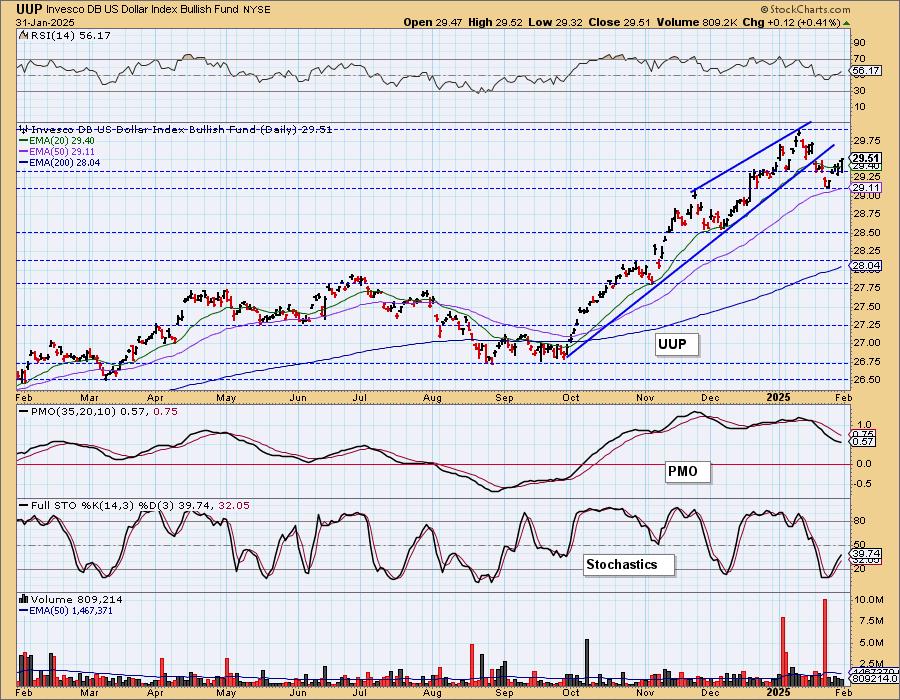
UUP Weekly Chart: The weekly PMO had topped, but it has turned back up so we have a PMO "Surge" above the signal line. The rising trend and breakout from the bearish rising wedge is especially bullish.
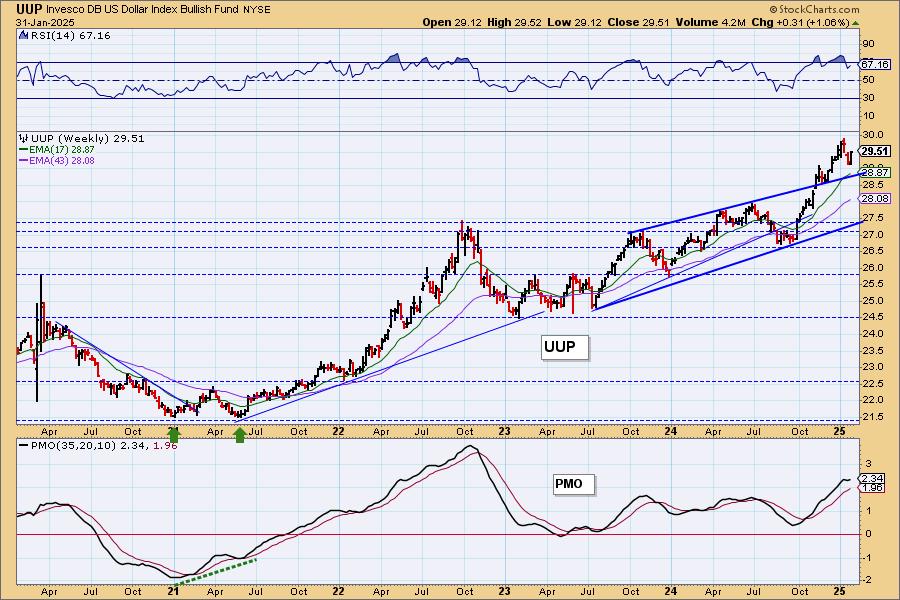
UUP Monthly Chart: Price is in a near vertical rally and those are hard to maintain, but given the very favorable monthly PMO, we should see higher prices. We just need to stay alert to a possible break of this steep rising trend.
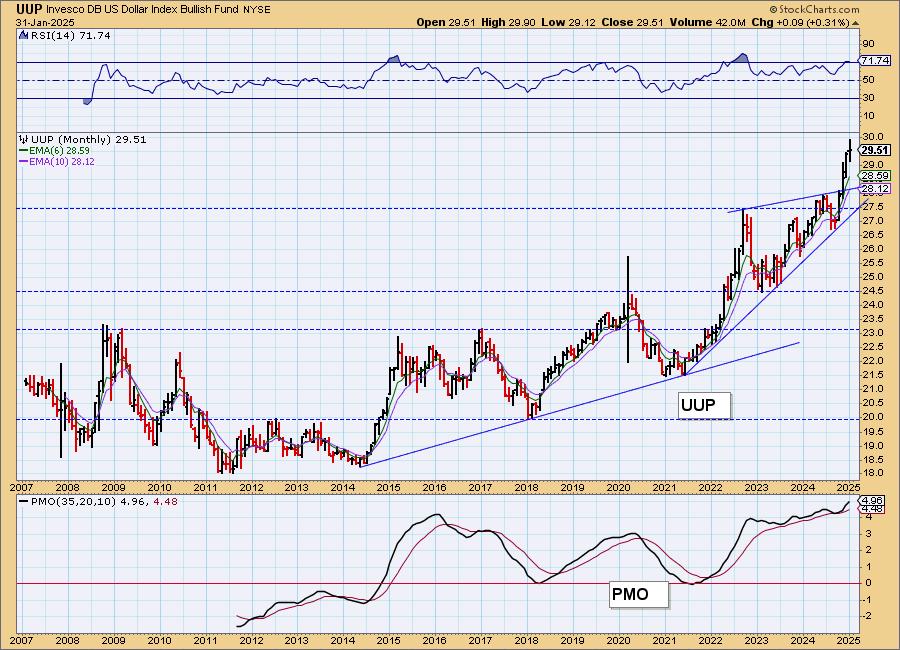
GOLD
IT Trend Model: NEUTRAL as of 12/23/2024
LT Trend Model: BUY as of 10/20/2023
GLD Daily Chart: Gold made another all-time high today. The rising Dollar isn't bothering it. The chart is very bullish. We have a positive RSI, a rising PMO and Stochastics above 80. Discounts are expanding somewhat so investors are apparently a bit more bearish on the metal. Deep discounts can be favorable for Gold as sentiment is contrarian.
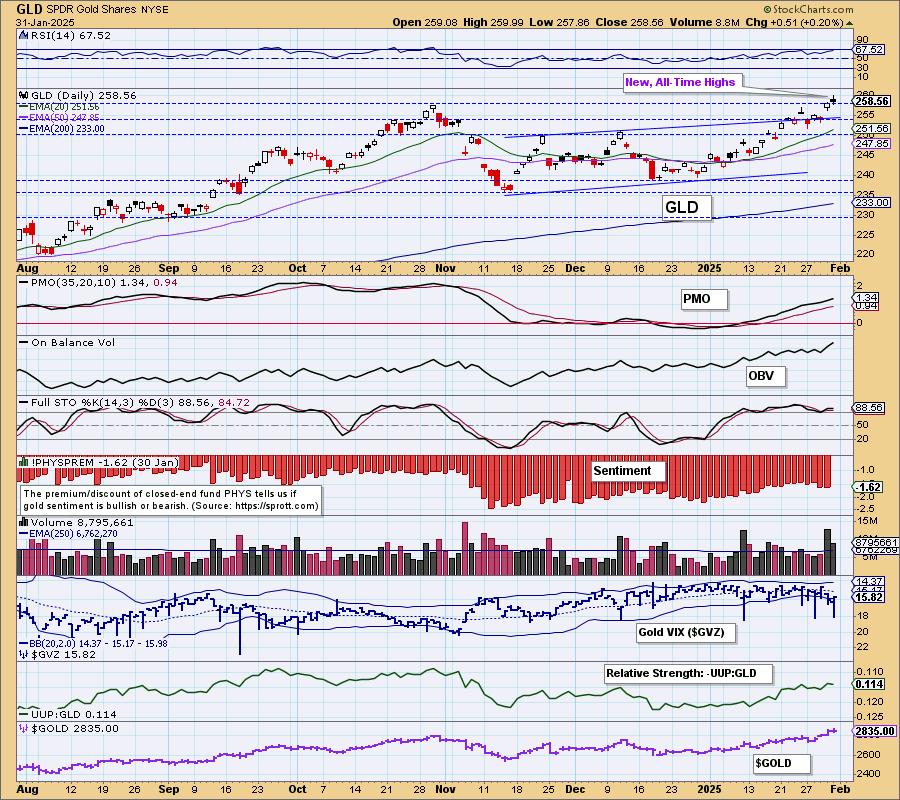
Gold is showing relative strength to the Dollar right now and thus could continue to buck the trend of the inverse correlation between the two. We would like to see the correlation get less negative as the Dollar does look very bullish right now and we don't want those headwinds for Gold.
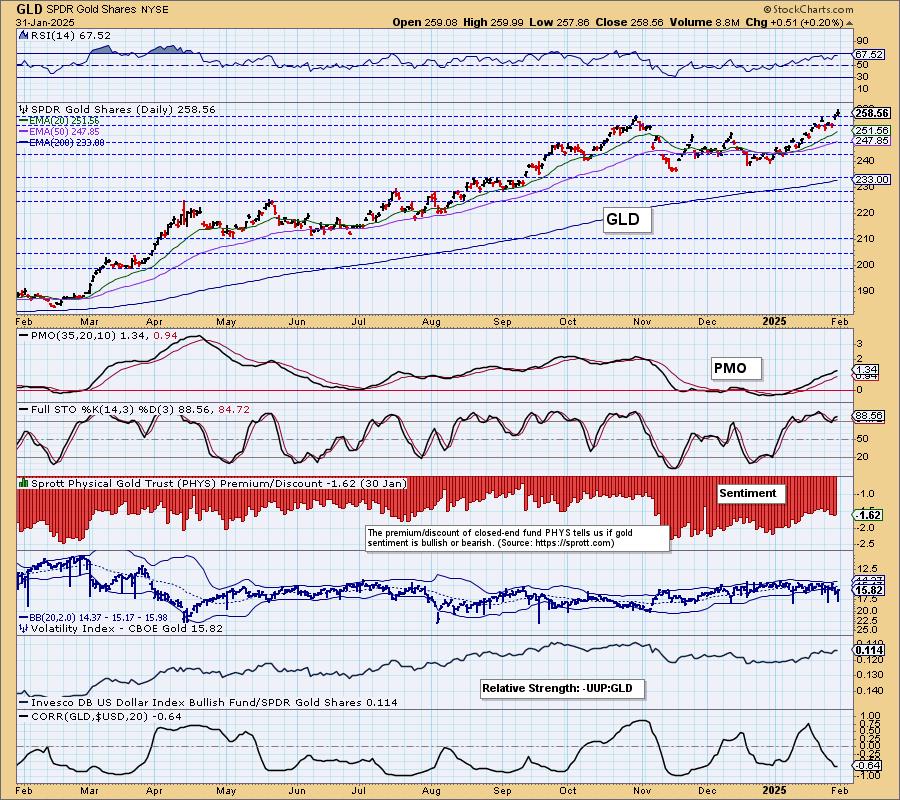
GLD Weekly Chart: We had a parabolic breakdown and now Gold is resuming its rally. The weekly PMO is beginning to rise again and the weekly RSI is not quite overbought yet. Even if it does get overbought, we can see that it has managed to get far more overbought and still hold together. It is a condition that needs to be monitored.
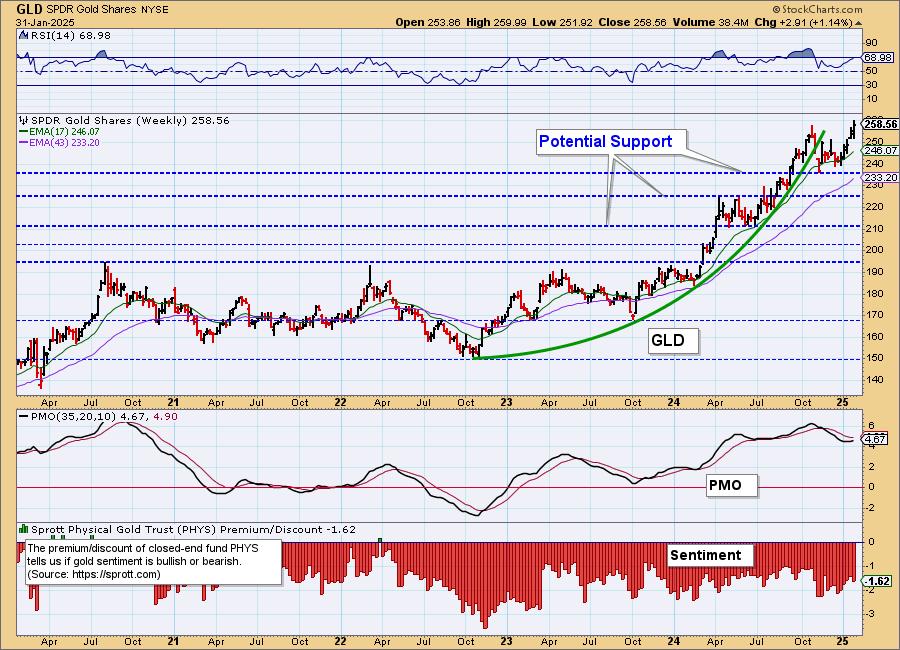
GLD Monthly Chart: We have a parabolic advance on the monthly chart that begs for a breakdown. However, the outlook for Gold right now is still bullish in our estimation so this rally could get more vertical on the monthly chart. The monthly PMO looks good. We do like seeing the long-term correlation between Gold and the Dollar as positive. As noted earlier, a bullish Dollar usually means decline for Gold, but in the long term that may not necessarily hold.
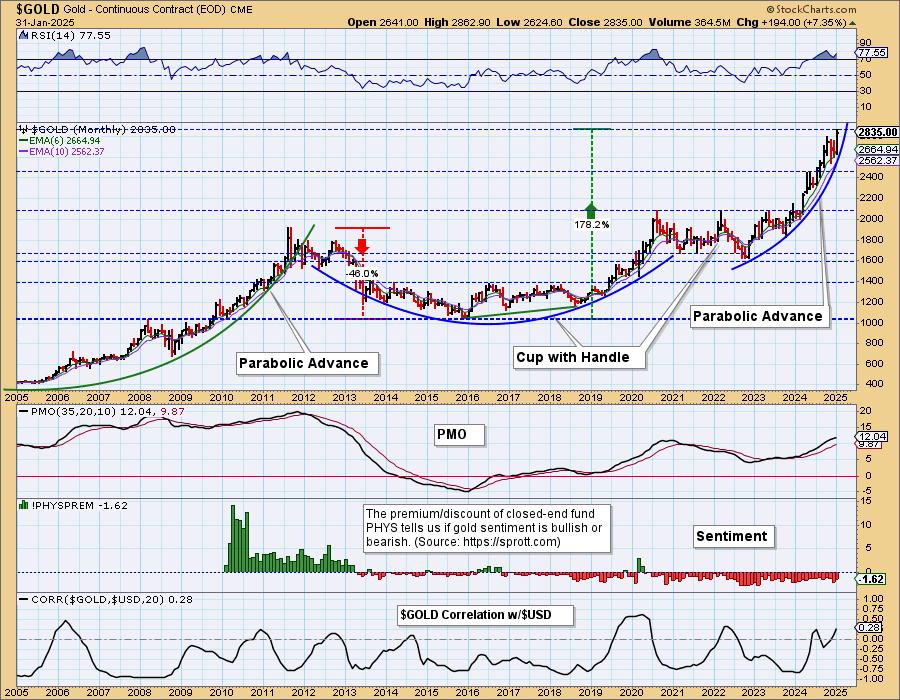
GOLD MINERS Daily Chart: Gold Miners got hit with the market's decline. Gold made an all-time high, but it wasn't enough to keep this group rising. We still like the group as indicators are bullish and participation is very strong. We also are bullish on Gold and that means we really have to be bullish on Gold Miners which generally follow Gold closely. Look for higher prices.
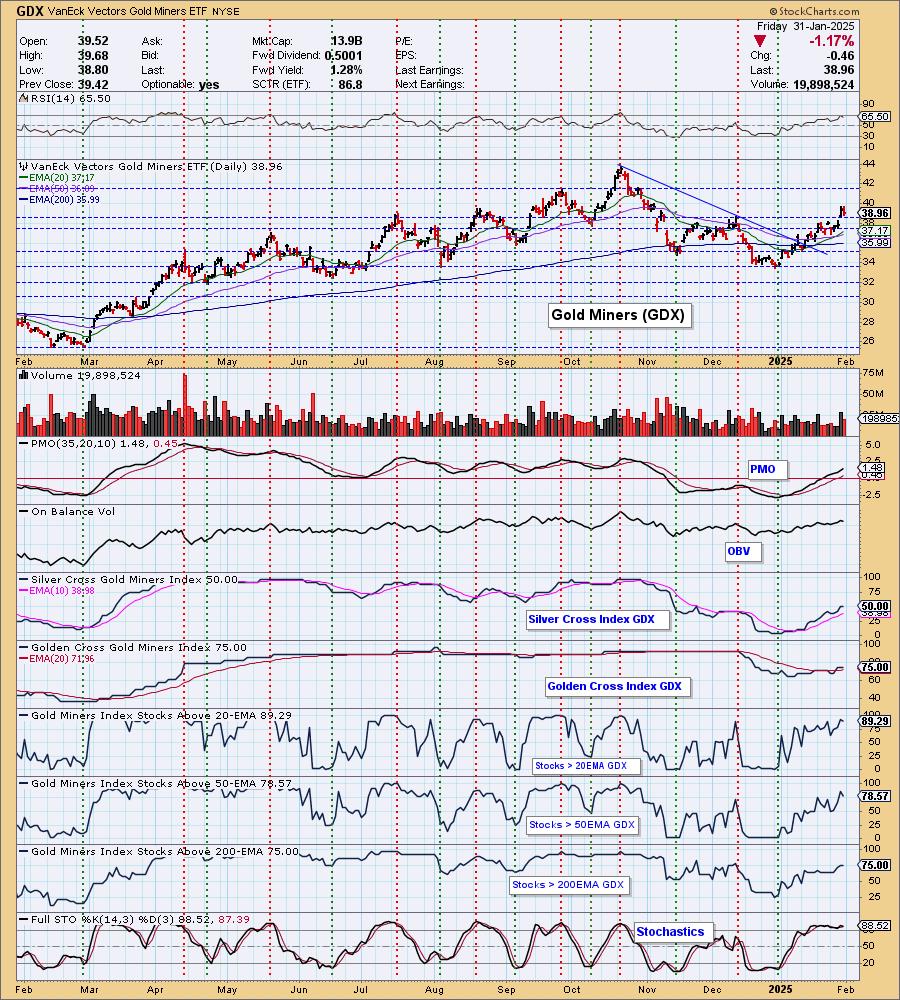
GDX Weekly Chart: We have a nice rising trend on the weekly chart and a weekly PMO that has turned up. We like GDX's chances of reaching the 2024 high.
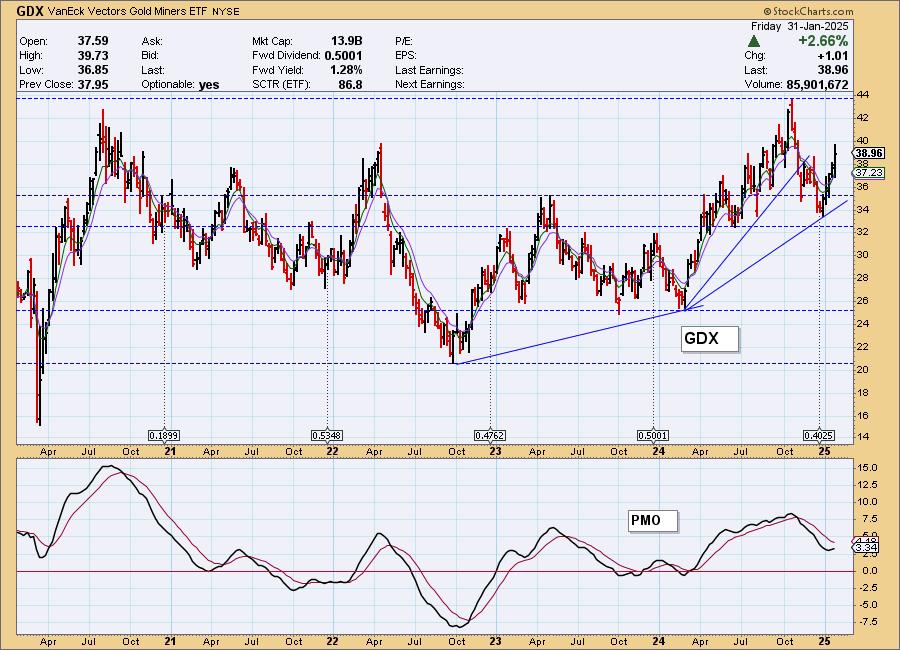
CRUDE OIL (USO)
IT Trend Model: BUY as of 12/24/2024
LT Trend Model: BUY as of 1/10/2025
USO Daily Chart: Crude Oil has hit support and it did manage a small rally. We still don't favor Crude as the PMO is still in decline and the fundamentals of a fossil fuel friendly administration that is pressuring OPEC+ to keep prices low. We suspect there is more downside to absorb.
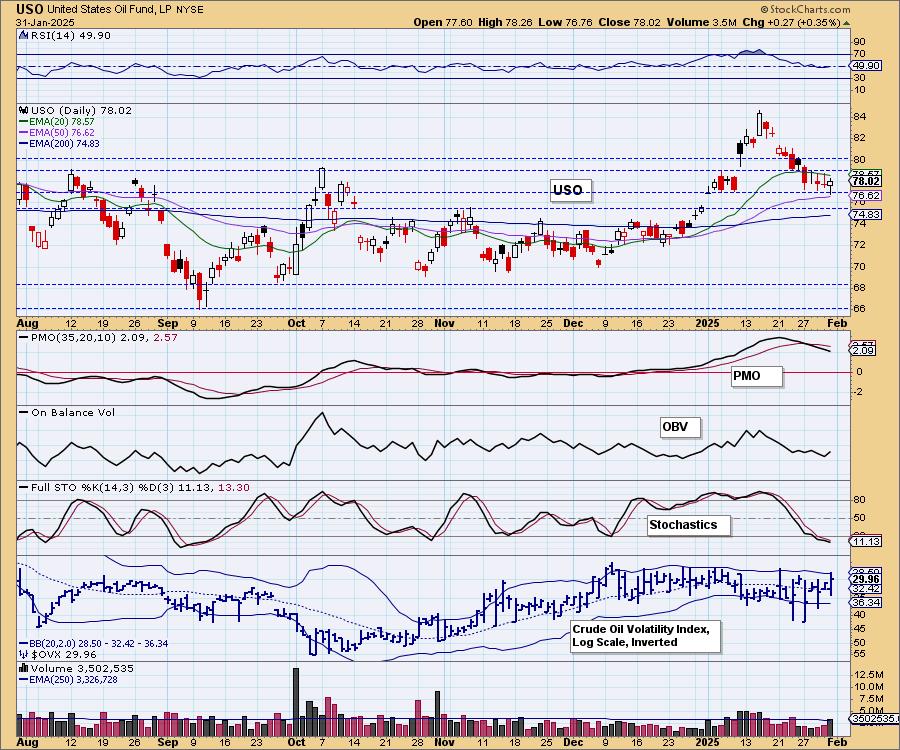
We should see price get to the 200-day EMA soon but recognize that the 50-day EMA could provide some support first.

USO/$WTIC Weekly Chart: Crude is in a long-term trading range and we see no reason why this won't continue. Price hit overhead resistance and is declining. The weekly PMO is still rising, but overall it is hugging the zero line which is about as neutral as you can get.
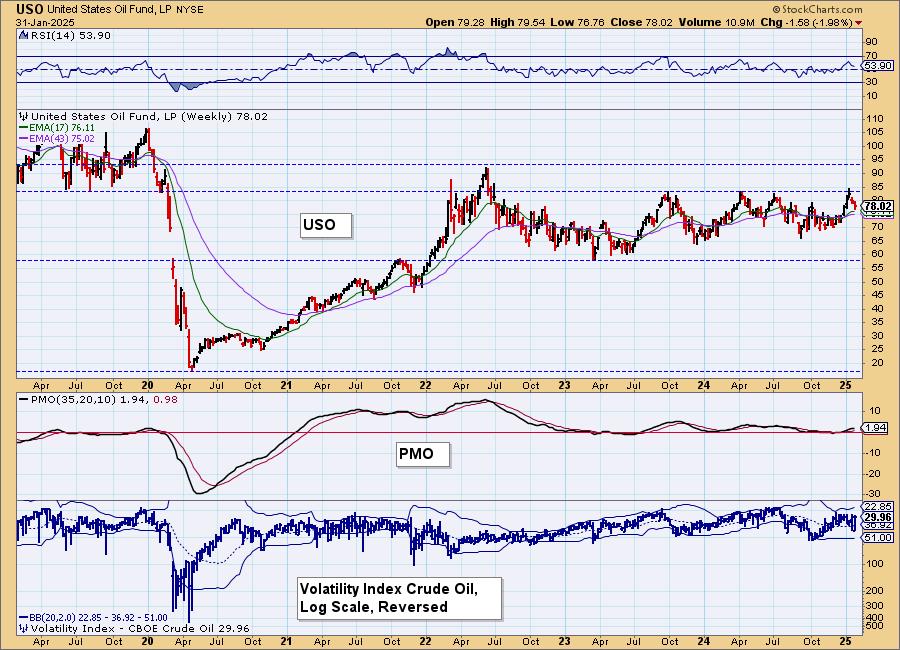
WTIC Monthly Chart: West Texas Crude ($WTIC) found support and is essentially rallying from there. However, we note a declining trend and a weekly PMO in decline. We should see support tested another time.
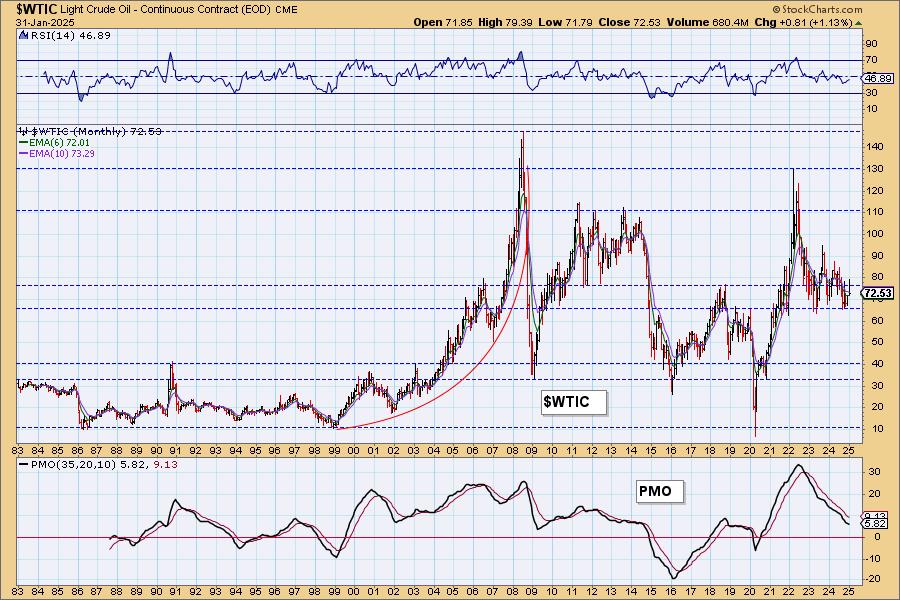
Good Luck & Good Trading!
Erin Swenlin and Carl Swenlin
Technical Analysis is a windsock, not a crystal ball. --Carl Swenlin
(c) Copyright 2025 DecisionPoint.com
Disclaimer: This blog is for educational purposes only and should not be construed as financial advice. The ideas and strategies should never be used without first assessing your own personal and financial situation, or without consulting a financial professional. Any opinions expressed herein are solely those of the author, and do not in any way represent the views or opinions of any other person or entity.
DecisionPoint is not a registered investment advisor. Investment and trading decisions are solely your responsibility. DecisionPoint newsletters, blogs or website materials should NOT be interpreted as a recommendation or solicitation to buy or sell any security or to take any specific action.
NOTE: The signal status reported herein is based upon mechanical trading model signals, specifically, the DecisionPoint Trend Model. They define the implied bias of the price index based upon moving average relationships, but they do not necessarily call for a specific action. They are information flags that should prompt chart review. Further, they do not call for continuous buying or selling during the life of the signal. For example, a BUY signal will probably (but not necessarily) return the best results if action is taken soon after the signal is generated. Additional opportunities for buying may be found as price zigzags higher, but the trader must look for optimum entry points. Conversely, exit points to preserve gains (or minimize losses) may be evident before the model mechanically closes the signal.
Helpful DecisionPoint Links:
DecisionPoint Alert Chart List
DecisionPoint Golden Cross/Silver Cross Index Chart List
DecisionPoint Sector Chart List
Price Momentum Oscillator (PMO)
